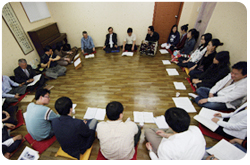Intangible Cultural Heritage of Humanity
Intangible Cultural Heritage of Humanity- Republic of Korea
-
Gagok, lyric song cycles accompanied by an orchestra
Slow Lyrical Songs of Poetry
Gagok for Entertainment of Hermit Sages
Gagok refers to a genre of Korean vocal music composed from traditional three-line poetry (sijo) and accompanied by an ensemble of native instruments, consisting of a twelve-stringed, or else six-stringed, zither (gayageum or geomungo), a large, or else small, bamboo flute (daegeum or sogeum), a two-stringed zither (haegeum) and a two-sided drum (janggu). In the Joseon Dynasty (1392-1910), vocal music was roughly divided into two kinds according to the class of people who enjoyed them.First, aristocrats and literati enjoyed three genres of songs composed from poetry. The term “sijo” mentioned above refers not only to the poetic genre itself but also the songs composed from the poetry - the songs with simple melodies and rhythms, which were often sung without accompaniment. On the other hand, if the same poetry was set to more sophisticated songs accompanied by an ensemble it was called gagok. Lastly, songs composed from the prose-poetry named gasa were longer and had more complicated melodies. 
These three types of vocal music enjoyed by the aristocracy were nicknamed the “proper songs (jeongga)” to distinguish them from commoners’ songs, such as the pansori epic chant, folk songs (minyo) and other “miscellaneous songs” (japga). Among the three types of “proper songs,” gagok is considered to be the most artistically sophisticated form.
Most of the gagok songs are very slow, with lyrics composed of about 40 syllables uttered in 11 minutes, and melodies ranging within only two octaves. The clearly enunciated lyrics and serene melodies make the songs easy to understand. A gagok song consists of five chapters, including an instrumental prelude (daeyeoeum) and interlude (jungyeoeum), combining vocal and instrumental music in a single piece.
The songs of gagok enjoyed in the early Joseon era had three different tempos: The songs with slow, medium and fast tempos were called mandaeyeop, jungdaeyeop and sakdaeyeop, respectively. However, the slow- and medium-tempo songs have disappeared, and the present form of gagok has been derived from the fast-tempo variety.There are about 40 pieces of gagok that have been transmitted until today. These songs have adopted three different modes: the pyeongjo mode used for peaceful and placid melodies; the ujo mode, for bright and energetic melodies; and the gyemyeonjo mode, for sad and plaintive melodies. Some of the songs are supposed to be performed by male solo singers, some by female solo singers, and the others by male-female duets. 
For example, the lyrics and the performance detail of a song titled “The Willow Becomes Thread” are as follows (It is a female solo piece in the placid pyeongjo mode with the fast sakdaeyeop tempo.):
(Instrumental Prelude)
(Chapter 1) The willow becomes thread
(Chapter 2) The nightingale becomes a shuttle
(Chapter 3) Together they weave a fabric of my sorrow for ninety days of spring
(Interlude)
(Chapter 4) So, tell me.
Who is it that says the time of green trees and fragrant grass
(Chapter 5) Is even better than the time of flowers?
(Postlude)
In Korean, the lyric consists of just 43 syllables, and the song is performed for over 11 minutes. Singing such a slow song for over a 10 minute period is considered sufficient to calm one’s mind, wiping away anxiety and sadness. Although these songs are neither exciting nor cheerful, they are attractive in a serene, elegant and meditative manner. Neither high-strung nor lax, the tunes flow softly and resonantly.
Experts of world music have shown special interest in the Korean lyric songs of gagok, praising them as “songs that cleanse one’s body and soul,” or “the slowest songs in the world, an entertainment for hermit sages.” The lyric songs of poetry, if presented to the wider public, would likely be enjoyed and loved by music fans all over the world, serving as a cultural medium to spread Korean culture around the world.



 >
>